
28 minute read
FEATURE
Fast Times in Mexico
Our man travels to a quiet corner of the Yucatan and discovers some of the most frenzied fishing on the planet.
BY NICK HONACHEFSKY
Our flight touched down at midnight in Cancun, Mexico. My girlfriend Emily and I hopped a shuttle and cruised south along the Riviera Maya, the stretch of coastline on the northeastern tip of the Yucatan Peninsula. Offshore lies the cruise ship hub and scuba paradise of Cozumel.
Along the coast are a series of popular tourist stops, all with their own flavor. We made our way past the pool parties and spring break atmosphere of Cancun, past the beaches and golf courses of Playa Del Carmen, and then the Bohemian paradise of Tulum with its many spas. At the southern end of the coast, we finally arrived at Ascension Bay and the Pesca Maya Lodge. For anglers, this is where the real party happens. I call it piscatorial paradise.
Ascension Bay offers incredible inshore action from a boat or the beach. In some cases, wade fishing is the best option. Right: The author shows off a barracuda caught just steps from his bungalow.
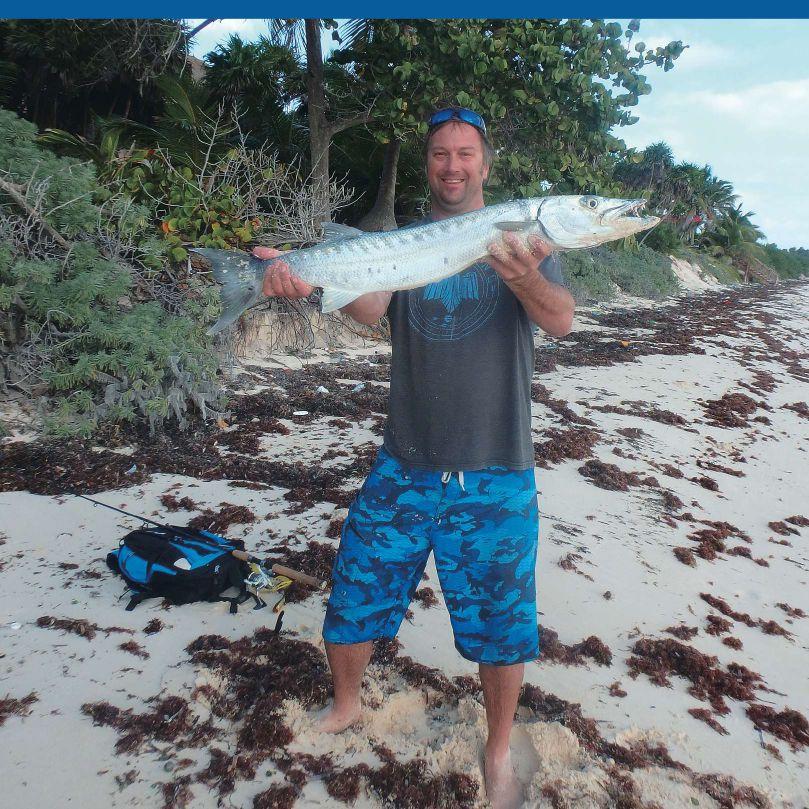
Ascension Bay is a dreamland of bonefish, permit, tarpon and snook. Throwing my bags down, I grabbed a strong Mexican coffee and cast a popper out into the Caribbean Sea, steps from my room at the lodge. Three casts out and I promptly brought in a 12-lb. great barracuda. The kitchen staff kindly (and expertly) turned it into an afternoon meal of ceviche. It was a great way to settle in, and as we ate, I wondered if all the fishing was going to be this sweet. The answer would come soon enough.
A half hour later, we set out with local guide Daurin Xec to the hallowed grounds of Vigia Chica. The Ascension Bay area prides itself on its numbers of bones, not necessarily big bragging weights, but lines are tight 24/7.
“Maybe you can get a 5-lb. Macabe (the Mayan name for bonefish) here,” said Daurin, “but we don’t generally have trophy fish around. However, if you want to cross a bonefish off your list, we have plenty 1- to 2-lb. fish.” I picked up the 9-weight fly rod and cast a shrimp fly into a small channel that cut through a flat of slick azure waters. “Strip, strip, strip!” commanded Daurin. I was tied tight to my first bonefish of the day, and then a dozen more, only hours after my flight landed.
Daurin was anxious for me to
experience some different types of fishing, so we moved on and he put the bow onto a sandspit beach— where you must be wary of saltwater crocodiles—and mate Venancio Chan, AKA Benny, and I stepped off the boat. We scurried through the palm tree underbrush looking to collect hermit crabs. We loaded a Tide detergent gallon container full and set out again to see what we could find.
Emily had never seen a bonefish before, much less caught one, but that didn’t matter. Benny hooked a hermit crab on a bucktail with a shrimp fly teaser, passed it to her, and with a couple quick twitches of the wrist, she was holding up a double-header of 2-lb. bonefish. The hermit crabs
caught the attention of a variety of bonefish, jack crevalles, ladyfish, pufferfish and blue runners, which kept Emily busy and smiling. The shrimp fly I kept flinging out also landed a variety of flats species until it came tight on something with a more pronounced wobble to its fight: an exquisitely finned palometa.
The day was over, with dozens of fish caught and released, but it wasn’t enough. As night fell, I cast chunk baits into the Caribbean surf just from my room. Above, I could spy the Milky Way white band in full effect overhead, and I caught tarpon and blacktip sharks nearly until the sun rose.
Day one seemed like it would be hard to beat, but Captain Daurin pointed us toward a 50-year-old shipwreck, a storm victim from the days of the bubblegum tree trade. (For centuries, the Mayans boiled tree gum into a sticky, multi-purpose substance called “chicle.” In the late 1860s, it was exported to the U.S. and used for bubble gum, including the popular Chiclets brand). Daurin said that permit should be sticking close to the wreck.
“Throw that ghost crab out there and see what happens,” said Daurin, as I lobbed the crab out on a 3/0 hook over the wreck and clicked over the
5 SPECIES, 1 BAIT MANGROVE MADNESS
Sleek and streamlined, bonefish use slick camouflage to blend into sunsprayed flats. Though bones rarely exceed 5 lbs. in Ascension Bay, the sheer volume of 1 to 2 pounders keeps the rod bent all day long.

bail. As I sat with the reel engaged, a massive hit left my hook empty and me and my rig shell-shocked. Twenty-pound permit. Lost. I was dejected. “Oh well,” said Daurin. “Win some, lose some.” It was the only permit we spied on the wreck, so it was time to move on to better things, into the mangroves.
“Let’s put some mojarra chunk out there, along the mangroves. We get some big fish,” said Daurin. I was in total agreement. I flipped a chunk bait straight between two mangrove roots under the canopy, and just let it sit. “Be ready, they will be here,” said Daurin confidently. In an instant, my line went slack, the bait rushing toward me. I reeled as fast as I could and came tight, real tight, when a 10-lb. tarpon jumped to its freedom, snapping my 40-lb. test.
Another chunk bait was cast into a shadowy hole between the mangrove roots, but this time I was deep. My drag peeled hard, this fish put the business to me, tangling my line in the mangrove roots. I released the reel into freespool, allowing the fish to find its way out of the mangrove maze when the net finally scooped up an 8-lb. Cubera snapper. “Dinner!” shouted Daurin and Benny in excited unison.
I was pleased, but not totally satisfied just yet. Breaking off that tarpon still had a grip on my psyche, so I sent out another chunk. This time I was prepared. The tarpon jumped four feet, clean out of the water, shaking its head in frustration, but I kept my rod low. In a few minutes, I had a 10-lb. tarpon boatside. I reached down and took my other hook out of its mouth—which it claimed only 10 minutes before—and we released it. I felt an immense sense of accomplishment.
The next day, we hit the flats again. On the way out, we passed pink flamingos sinking their curved beaks into the mud searching for crabs and shrimp. We finally cut the motor to pole around fallen logs and brush piles alongshore and sight cast for snook.
“OK, there, there!” Daurin pointed toward a sunken log. Three, 10-lb. snook were lined up lying in wait. I launched a bright yellow (Mosca) streamer fly, cajoling a fat, 10-lb. snook to come off his lair. I stripped. He followed. I kept stripping, he followed more, right to the boat. And then he turned off. “Ahhh!” I exclaimed, exasperated.
I asked Daurin, “Can we cast from the beach?” Daurin obliged. “Yes, I know a good spot.” We gently pushed the bow onto a sandbar and broke for lunch.
THE LAST STAND
Dropping a shrimp fly in ditch channels, surprise catches always pop up, this time in the form of a lookdown. Other odd characters in ditch cuts found off sandbars include palometas, ladyfish, jacks and if Lady Luck shines upon you, permit.

Emily hopped off the boat to take a few photographs in the distance, but she was quickly waving her arms, shouting and pointing, “Two bonefish! Right here!”
Daurin and I lazily ate our ham sandwiches and brushed her off, thinking we would wade over there soon enough to cast. But Emily was persistent, “ They are right here!”
We jumped off the boat and found out why she was so excited. Two bonefish had gotten trapped by the low tide and were finning around in their own private pool of seawater. Daurin and I grabbed the net off the boat and in a circus-like scene chased the bones around until we scooped them up and released them into the bay.
Life was good, for the bones and for us. To finish the day, I planted my feet and cast into the blue waters and soaked up a little bit of fishing heaven. One strip after another, my fly came tight to a mess of bonefish, jack crevalles, palometas and—a prized jewel for me—two huge, atavistic lookdowns. It doesn’t take a trophy gamefish to make me happy. Just to land a look down on fly, along with scores of bonefish and palometas was more than enough.
That night, we ate dinner and prepared for the trip home the following day. But I wasn’t done fishing, of course! Around 10pm, with stars twinkling brightly against jet black skies, I set out with my spinning gear to chunk mojarra baits off the beach. The line went slack and then things went wild. My reel was burning off line for about 15 seconds, and then that was it. The beast on the end simply spooled me. Tarpon? Shark? Snook? I’ll never know. One thing I do know is that I’ll be back to Pesca Maya to finish the fight.
YUCAtan peninsula
gulf of mexico
COZUMEL
Ascension Bay
where to, captain?

The Riviera Maya corridor winds through Mexico’s Quintana Roo Province along the Caribbean Sea, ending at Ascension Bay. Myriad mangrove islands within the bay attract snapper, grouper, tarpon and snook to hide among the roots in the shade of the searing sun, but clear flats open up possibilities and opportunity to spy permit tailing, bonefish funneling down a shoreline and snook hanging tight to fallen logs and sunken tree trunks.
Vigia Grande provides opportunities to target permit while bonefish schools tend to amass in the Vigia Chica proper. No one spot is more than a 45-minute to an hour run in the big bay, so charter captains can usually pick up and make a move to find more productive grounds if necessary.
Pesca Maya Lodge is at the epicenter of Ascension Bay activity, offering proper flycasting equipment, a storied lodge lounge and dining room, and a safe and secure property where you can leave your door open the entire day. Most importantly, the lodge’s rooms are a dozen steps to the Caribbean Sea when you need to wet a line even after you are “done” fishing for the day.
Special thanks to the amazing staff and guides at Pesca Maya Lodge. For more information on fishing Ascension Bay, visit www.pescamaya.com. Pesca Maya offers services for fishing and lodging all over the Yucatan peninsula.
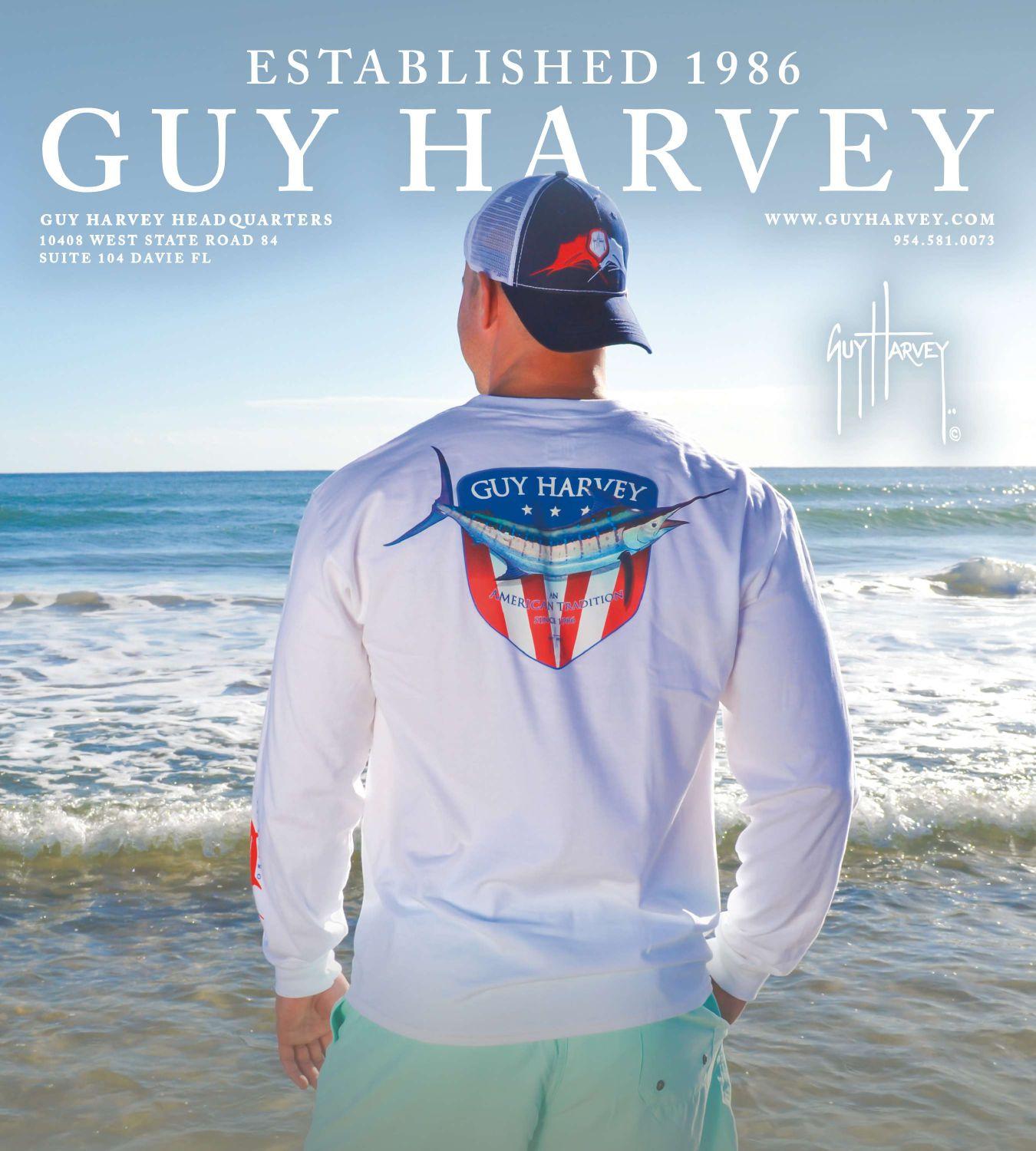
When the weather is at its worst, be sure to dress your best.
G E A R H E A D S:
BY GHM STAFF

A small investment in foul weather apparel can pay big dividends in your fishing. If you haven’t checked out the latest gear in a while, you’ll be impressed with the range of technical fabrics that combine waterproof protection with real breathability. Jacket and bib designs offer great freedom of movement and are comfortable to wear all day long. Hand warmers, gear storage and a host of other innovations have also made foul weather gear truly functional. There’s no reason to let a little rain or cooler temps keep you sidelined. Get dressed and go fishing. You won’t catch anything at the dock.
Gill FG21 – Tournament Jacket
This high-performance jacket is built to keep heat in and wind and spray out so tournament anglers can put in the long hours it takes to win. When running at high speed, the hood design helps direct airflow around the head for a more comfortable ride while also keeping the hood in place. • Retractable cuff adjustors with inner seals for watertight comfort • Hand warmer pockets behind deep cargo pockets • 2-way zippers protected by a double storm flap • High cut collar with brushed lining for facial comfort and warmth
MSRP $299 www.GillFishing.com
Grundens Hooksetter Shirt
Great for any weather, this technical long-sleeve shirt offers real sun protection for the nice days and dries quickly should you get caught in a summer squall. The articulated armpit design frees you up for poling and casting. • Water resistant/UPF 30 • Flap cover chest pockets • Snap chest utility pocket • Hidden shoulder blade vents
MSRP $70 www.Grundens.com

Gill FG23 Glove Frogg Toggs Pilot Guide Jacket
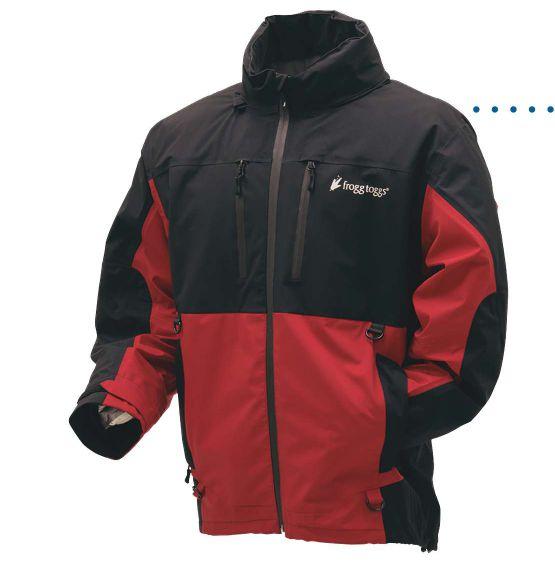
Second generation DriPore fabric is fully waterproof with excellent breathability, and the Pilot Guide Jacket has a rugged Teflon exterior coating and plenty of storage. It also boasts an insulated liner retention system and can be paired with the Co-Pilot Insulated Puff Jacket ($79) or Vest ($69) for extreme cold. • Vented, removable hood • Internal adjustable wrist gaskets • Beefy #8 chest zipper • Large internal dry-storage pocket MSRP $169.99 www.FroggToggs.com
Driving boats at high speeds in cold weather is tough on the hands. Gill’s FG23 gloves deliver insulated warmth and waterproof protection so drivers can keep a solid grip on the wheel. The “no-seam” fingertip design also improves dexterity. • Waterproof, breathable Porelle membrane • Thinsulate insulation works even when damp • Lens wipe on the outside of thumb • Can be layered with Gill’s FG22 Glove for extreme conditions MSRP $49.95 www.GillFishing.com
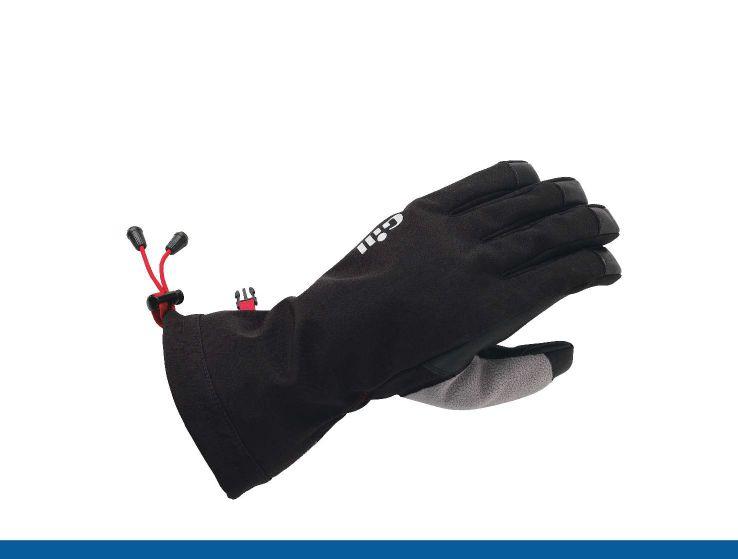
Columbia PFG Force 12 Jacket
When fishing means operating in a steady rain, the Force 12’s fully sealed seams and breathable, waterproof technology keep the weather at bay. Also notable is the waterproof pocket with a touch-screen compatible window. Secure it to the jacket’s front, the left forearm or tuck it inside. • Attached, adjustable hood • Abrasion-resistant overlays • Adjustable cuffs and brimmed hood • 360° reflective MSRP $500 www.Columbia.com

Columbia Force 12 OutDry Extreme PFG
These lightweight shoes help anglers keep their footing in sloppy conditions. They feature Columbia’s OutDry Extreme waterproof, breathable construction and a Vibram outsole for a solid grip on wet decks and docks. • VIBRAM PU-like midsole compound for long-lasting comfort • Special shank for torsional stability • Non-marking WAVEGRIP outsole for watersport surfaces MSRP $150 www.Columbia.com

AFTCO Anhydrous 3L Waterproof Bib
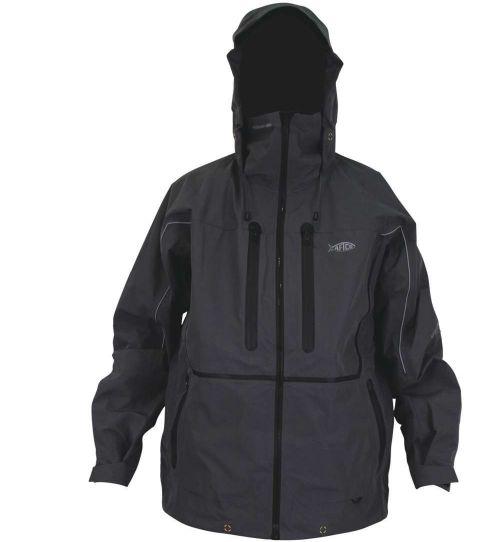
• Two cargo pockets and two zippered chest pockets • Built-in suspenders keep bibs secure • Water-resistant YKK zippers protect pocket contents • Rugged material resists abrasion in high-wear zones
MSRP $345 www.AFTCO.com
AFTCO Anhydrous 3L Waterproof Jacket
Made from a 3-layer technical fabric, Aftco’s Anhydrous garments form a truly waterproof barrier, yet still allow for breathability to reduce clamminess against the skin. A waterproof YKK Vislon zipper and taped seams prevent seepage at every entry point. • Articulated sleeves and cuff gaiters • Dual-zippered chest pockets with • water-resistant zippers • Drawcord waist cinch system MSRP $395 www.AFTCO.com
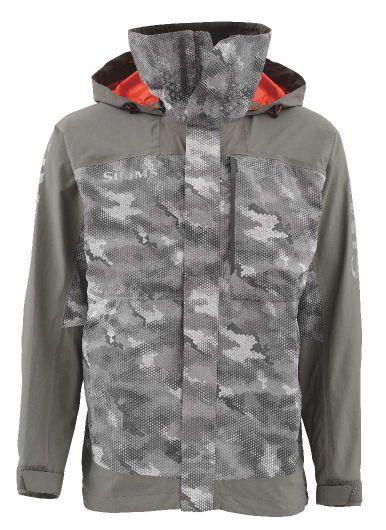
Simms Challenger Jacket
When you need to hunker down, the Challenger jacket protects anglers with 100% waterproof, breathable fabric and an adjustable storm hood that stows away in the collar until needed. When the weather is cold, you can warm up your hands in fleece-lined pockets. • Fully taped seams for 100% waterproof performance • YKK Vislon zipper with exterior storm flap • Dual drawcord adjustable bottom hem • Dual kill switch anchor points MSRP $199.95 www.SimmsFishing.com
Simms Challenger Bib
• Adjustable hem and suspenders for a more customized feel • Single thigh pocket with a reinforced tool sheath • Hand warmer pockets • Fully taped seams for 100% waterproof performance
MSRP $199.95 www.SimmsFishing.com
Grundens Breakwater Pants
Designed for all-day wear and perfect for fending off nasty spray and intermittent showers, these pants also stand up to the scales and slime that come with saltwater action. Reinforced at critical wear points, the Breakwater boasts 4-way stretch and articulated knees for easy movement. • Quick dry/UPF 50 • Mesh vent hand pockets • Flap cargo pockets • Crotch gusset
MSRP $89.99 www.Grundens.com

Frogg Toggs Pilot Guide Bib
• Easy-access, quick-drain, expandable cargo pockets • Full front zip and zip-to-knee side zips for fast and easy on and off • Zippered chest storage pockets • Multiple D-rings • Comfort stretch suspenders with locking buckles
MSRP $149.99 www.FroggToggs.com
MEET THE CHEF
HOMEGROWN
BY GHM STAFF
This issue, we feature three great chefs, all natives of Mississippi and each one turning out inspired seafood in their own hometowns.

Chr is Garret t
T H E C H I M N E YS R E S TAU R A N T
G U L F P O RT, M I S S I S S I P P I
Arrive at The Chimneys Restaurant in Gulfport and you are instantly immersed in serious Mississippi charm. The building boasts big southern porches and the white tablecloth dining room is both elegant and relaxed. Most importantly, the seafood is fresh from the Gulf of Mexico and Chef Chris Garrett loves to keep both the product and the flavors local. Speckled trout, redfish, Gulf shrimp and cobia are all seasonal staples. “We cook with a bit of New Orleans flair, but I don’t try to overdo a lot of products,” says Garrett, who advises home cooks to also take a restrained approach to seafood. “If it’s a nice cut from a fresh, quality fish… salt, pepper, fresh herbs and a little lemon juice go a long way. Keep it easy on the seasonings and adjust as you go. Just let the fish work for you,” he says. The 34-year-old Garrett cut his culinary teeth at the Chimneys as a teenager working in the kitchen and the self-taught cook became executive chef in 2004. A veteran of the United States Marine Corps, he also served in Iraq in both 2003 and 2005. He returned to The Chimneys full time in 2009 and continues to keep the perfect balance between fresh Gulf seafood and seasonal specialties. From time-to-time, Garrett also hosts a “beer dinner,” where the restaurant partners with a local supplier and Chef Garrett prepares a 6- or 7-course meal. Dishes, including gumbos and fish or shrimp preparations, are paired with different brews. It’s upscale dining with a relaxed, southern spin. www.chimneysrestaurant.com

Trout with shr imp, crab, citr us but ter
Speckled trout fillet 3 Fresh shrimp 2 oz Fresh lump crab 1 Crushed garlic clove 1 tbsp Olive oil 1 oz Dry white wine 1.5 oz Pineapple juice 2 oz Orange juice Bell Pepper (optional) Red onion (optional) Salt, pepper, and cayenne to taste Cold butter
Preparation
Start with a hot pan and add oil. Allow to heat. Season the fish fillet (salt, pepper, cayenne) and place in pan on medium heat. Cook 2 minutes on each side, then remove fish. Add the shrimp, crab, peppers, onions, and garlic to the pan and season to taste (salt, pepper, cayenne). Add white wine and cook an additional minute. Add all the fruit juices, cook 2 more minutes or until liquid reduces by half. Finally, add butter and green onions and then ladle entire contents over fish to serve.

But ter Poached Shr imp
1 lb Unpeeled, head-on Gulf shrimp 1.5 lbs Unsalted butter 1/4 C Dry vermouth 3 Cloves garlic 1 Bay leaf 1 tsp Chili flakes 1 Star anise pod 1 tsp Smoked paprika
Alex Perr y
V E S T I G E R E S TAU R A N T O C E A N S P R I N G S , M I S S I S S I P P I
If you feel like chucking southern tradition but still want incredible seafood, you might put Vestige Restaurant on your itinerary. Nestled in downtown Ocean Springs, Vestige offers up seafood with a modern American twist. Chef Alex Perry owns and operates the popular eatery with his wife Kumi Omori, and the pair strive to keep things local, seasonal and sustainable. Perry has a background in biology, but eventually abandoned the lab for the kitchen. After graduating from culinary school, he found his way back to Ocean Springs and opened Vestige to offer something unique. “Most of the fine dining restaurants were New Orleans-style with lots of cream sauces,” says Perry, “but no one was really taking advantage of what Mississippi has to offer with proteins and vegetables with seasonal and a lighter approach. We wanted to let the food be what it should be.” When it comes to seafood, Vestige sources from all along the Gulf Coast, including some farmraised fish such as striped bass and redfish from the region. They also take advantage of local blue crabs, oysters and shrimp. And the key to preparing any of it, says Perry, is to avoid the unforgivable sin of overcooking. “ That’s why I enjoy cooking fish the most,” he says. “It’s a finesse thing. Cooking fish per fectly over a high volume takes some finesse and some skill.” www.vestigerestaurant.com
Preparation
Peel and devein shrimp and reserve the shells and heads. Heat a thin layer of canola oil in a heavy sauce pan and add shrimp shells and heads and cook until they take on a reddish color. Take care not to burn the shells. Turn the heat to low and deglaze with the vermouth. Reduce until dry. Next, add the butter, garlic and spices to the pan. Let the butter melt slowly. Once melted, cover and place it in a 200º oven for 8 hours. Remove the butter and strain through a chinois. Chill butter and reserve. Place the peeled shrimp and butter into a sous vide bag and draw a vacuum. Poach the shrimp in an immersion circulator set to 57º C for 20–25 mins, or until the shrimp are fully cooked. Remove from the bag, drain the butter, and season shrimp with Maldon salt and serve immediately.
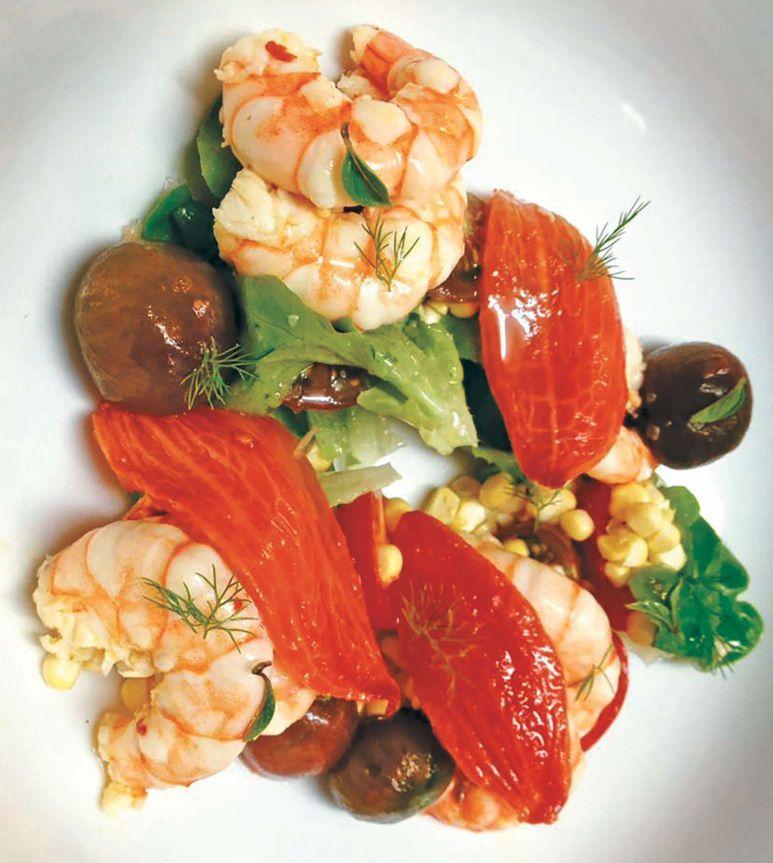
Jackson Shr imp with Comeback Sauce
3 lbs Head-on Gulf shrimp 3/4 C Powdered shrimp boil (Zatarain’s) 5 tbsp Salt 2 gal Water 3 Lemon 2 Bay leaf
Preparation
Bring everything except the shrimp to a boil and let simmer for 45 minutes. Taste and make sure the liquid is slightly less salty than the ocean. Bring pot back to a rolling boil and add shrimp. Once the shrimp come back to a boil, cut the pot off and ice the water. Depending on desired spice, let shrimp soak for 3–10 minutes. Remove from the water and serve with comeback sauce. Cooking tip: If your shrimp are shaped like a “C,” it means they’re cooked. If they are shaped like an “O” it means overcooked.
Comeback Sauce

1.5 C Mayo 1 C Diced yellow onion 3 oz Vegetable oil 6 tbsp Chili sauce 1.5 oz Ketchup 2 tbsp Worcestershire 2 tbsp Crystal’s hot sauce 3 tsp Yellow mustard 3 tsp Lemon juice 3 tsp Garlic 3 tsp Fresh black pepper 1 tsp Paprika or smoked paprika
Preparation
Combine all ingredients in a food processor and blend until smooth.
Alex Eaton
THE MANSHIP WOOD FIRED KITCHEN
J AC K S O N , M I S S I S S I P P I
Though a few hours from the coast, the city of Jackson is still home to great seafood, thanks in part to dedicated chefs such as Alex Eaton. In fact, Eaton holds the distinction of King of American Seafood. The lofty title was bestowed on the Mississippi native for winning the 2016 Great American Seafood Cookoff in nearby New Orleans. It was familiar territory for Eaton, who graduated from culinary school and spent time in several New Orleans kitchens, including that of well-known Chef John Besh. But after honing his skills, Eaton returned to the Jackson area to open a Table 100 in Flowood and then, more recently, the Manship Wood Fired Kitchen. “Our concept is the wood fired grill,” says Eaton. “On top of the grill is a rotisserie that we do all our meat on—chicken, pork shoulder, lamb. We also grill steaks and shrimp, and do all kinds of whole fish and wood fired oysters.” “Jackson is very seafood intense...people crave it. And a lot of places do southern cooking, but this is more of a Mediterranean feel. I’m a Lebanese American, so we decided to mix Mediterranean cooking with southern roots. It’s cooking with a high heat, and we finish things with olive oils and vinegars and salts, as opposed to using a lot of butter. This is much cleaner.” Another of Eaton’s seafood strategies, especially when it comes to fish, is to use as much of the animal as possible. “I order it whole and break it down to try and use it all,” he says, noting that he won the Great American Seafood Cookoff cooking red snapper collar (throat) and creating a broth using the fish bones. “I don’t think it’s something most home cooks try, so it was fun to have the crowd watch and see what it’s like.” www.themanshipjackson.com

HOOKED ON MISSISSIPPI

FRED GARTH
For the past 25 years, Fred D. Garth’s articles have appeared in numerous books, magazines and newspapers around the world. Read his blog at: GuyHarveyMagazine.com The reputation artists have for being eccentric— As it turns out, Anderson was diagnosed with a okay, let’s just say it, weird—fits many creative types like severe mental illness. So, he wasn’t acting odd to gain a handmade sequin glove. However, not all artists live attention. Even though he battled demons, he produced in a bizarro world. Working with Guy Harvey has taught a prodigious amount of amazing art. Today, he’s me this. And, my wife, a lifelong artist, is one of the most celebrated as a visionary, and Ocean Springs counts him responsible and agreeable people on the planet. She as one of their greatest celebrities. forced me to say that. After a tour of the Anderson Museum, our plan was
So when the staff here at Guy Harvey Magazine to have an intimate gathering with some key folks in the began our journey to produce this issue, we decided to Mississippi fishing community. My old friend, Bobby Carter, put on our funkiest outfits and visit the home of one of who is the director of the Mississippi Gulf Coast Billfish America’s early marine artists—a man who exuded epic Classic, agreed to organize the get together. Bobby lives levels of weirdness: in Ocean Springs but handles Walter Anderson. Breaking bread and trading “player acquisition” at the Golden
A longtime resident Nugget Resort and Casino in Biloxi, of Ocean Springs, stories with fishing legends where the annual billfish tourney Mississippi, Anderson is always an honor and is held. One thing I’ve learned was shunned by his about Bobby: he goes big. Not local community for usually humbling. surprisingly, our little meeting being downright evolved into a full-on shindig with strange. Beginning in the 1930s, Anderson would leave more than 20 people at Off the Hook restaurant. When I saw his wife and kids for days and weeks at a time and row his the fresh red snapper and shrimp that had been caught that small, wooden skiff 12 miles out into the often dangerous day in local waters, I knew we’d be in for a feast. waters of the Gulf of Mexico. His destination was a small Bobby invited Jay Trochesset and Kenny Barhanovich, barrier island—Horn Island—a place he called inhospitable. two fishing icons who are members of the International Nonetheless, he visited often. He’d use his overturned boat Game Fishing Association’s “Legendary Captains and as a tent to sleep under. He walked among the alligators, Crew”—a group that only includes about 30 captains great herons, blue crabs, armadillos and other island worldwide. Folks like Bouncer Smith, Jose Wejebe and Peter creatures—subjects he painted prolifically. The artist was Wright are in the exclusive club, and there we were in little more comfortable getting vampired by mosquitos than ole Ocean Springs having dinner with two of them. mingling the folks in his local community. Even when he Interestingly, both men began working on fishing boats was home, he’d hide away in his “little room” and create. in Biloxi when they were in their early teens. Both of their (Sidenote: the Little Room is now part of the Walter fathers were pioneers in the charter boat business. And Anderson museum in Ocean Springs, and every inch of after more than 50 years, both Trochesset and Barhanovich floor, wall and ceiling is painted in colorful murals.) are still doing what they love on the water. Breaking bread
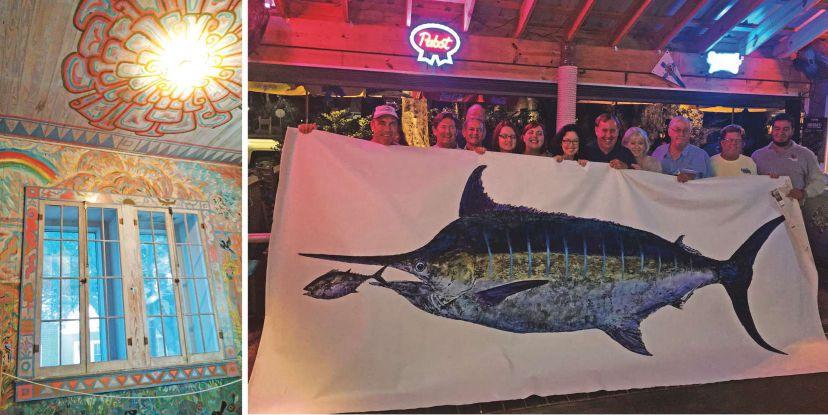
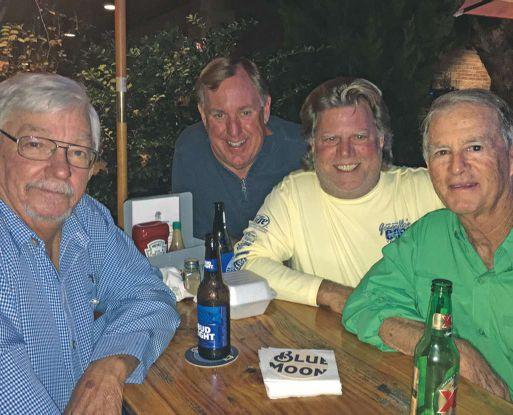

Clockwise from Left: The “Little Room” at the Walter Anderson Museum. Brumfield’s Gyotaku art of an actual billfish. Left to right: Kenny Barhanovich, Bobby Carter, Danny Pitalo and Jay Trochesset. Awesome beer taps at Chandeleur Island Brewing Company. GHM’s intrepid road trip crew: JJ Waters, Deveaux Carter, Penny Lane Jones and Carly Stone.
and trading stories with fishing legends is always an honor and usually humbling. My take away from these two gentlemen of the sea was how passionate they are about protecting the fishery for future generations. It’s a common thread I’ve heard from other iconic fishermen, once again proving that the leaders in our community are often the greatest advocates for conservation.
After some kind of amazing shrimp-in-garlic-butter dish, a giant portion of delicious snapper that would feed a small fishing club and a selection of fine beverages, we had bonded—the GHM staffers and the Mississippi fishing folks. One of our newest best friends was Craig Brumfield, an artist who I would say inherited a bit of that quirky gene. Among other art forms, Craig is into Gyotaku, an ancient Japanese method of putting paint on the fish’s skin, then rubbing the fish with rice paper to create a mirror image of the fish (in Japanese, Gyo means fish, and Taku means impression). Craig uses canvas instead of rice paper and some of his paintings are massive because he’s making Gyotaku of billfish. We ended the night attempting to get a photo of our eclectic crowd holding up one of Craig’s huge paintings.
The next day in our vision quest included a tour of another kind of art gallery, one where the medium is cold beer. It’s accurate to say that the dedicated folks at the Chandeleur Brewing Company treat their craft as fine art. We had a private tasting of several varieties of brewskis with names like Surfside Wheat Ale and Yellowmouth Tangerine Sour. After a night out with Bobby Carter, the tasting definitely took the edge off.
Owners and brothers Cam and Cain Roberds are hardcore fishermen, which is why they named their brewing company after their favorite fishing grounds, the Chandeleur Islands.
If you’re not familiar with the name Chandeleur, you should be. While the islands are technically part of Louisiana, they’re are closer to mainland Mississippi. Only 50 miles from the coast, the happy place is well-known for producing monster speckled trout and redfish. In addition to putting smiles on thirsty fishermen, the Cain brothers have also committed part of their profits to buying tags for tarpon. Conservation was turning out to be a theme.
We rounded out our tour of coastal Mississippi with a oyster extravaganza at the aptly-named Half Shell restaurant. I was reminded that the goal of the Mississippi Department of Marine Resources is to help local oystermen increase their output from about 40,000 sacks in 2015 to one million sacks of oysters by the year 2025. I’m not an overbearing boss but, right then and there, I strongly urged every member of my staff to put a dent in that oyster population and help create demand. We began our show of support at the Half Shell and we will continue our mission with fearless determination. That’s just the way the GHM staff rolls, especially in Mississippi.



AD
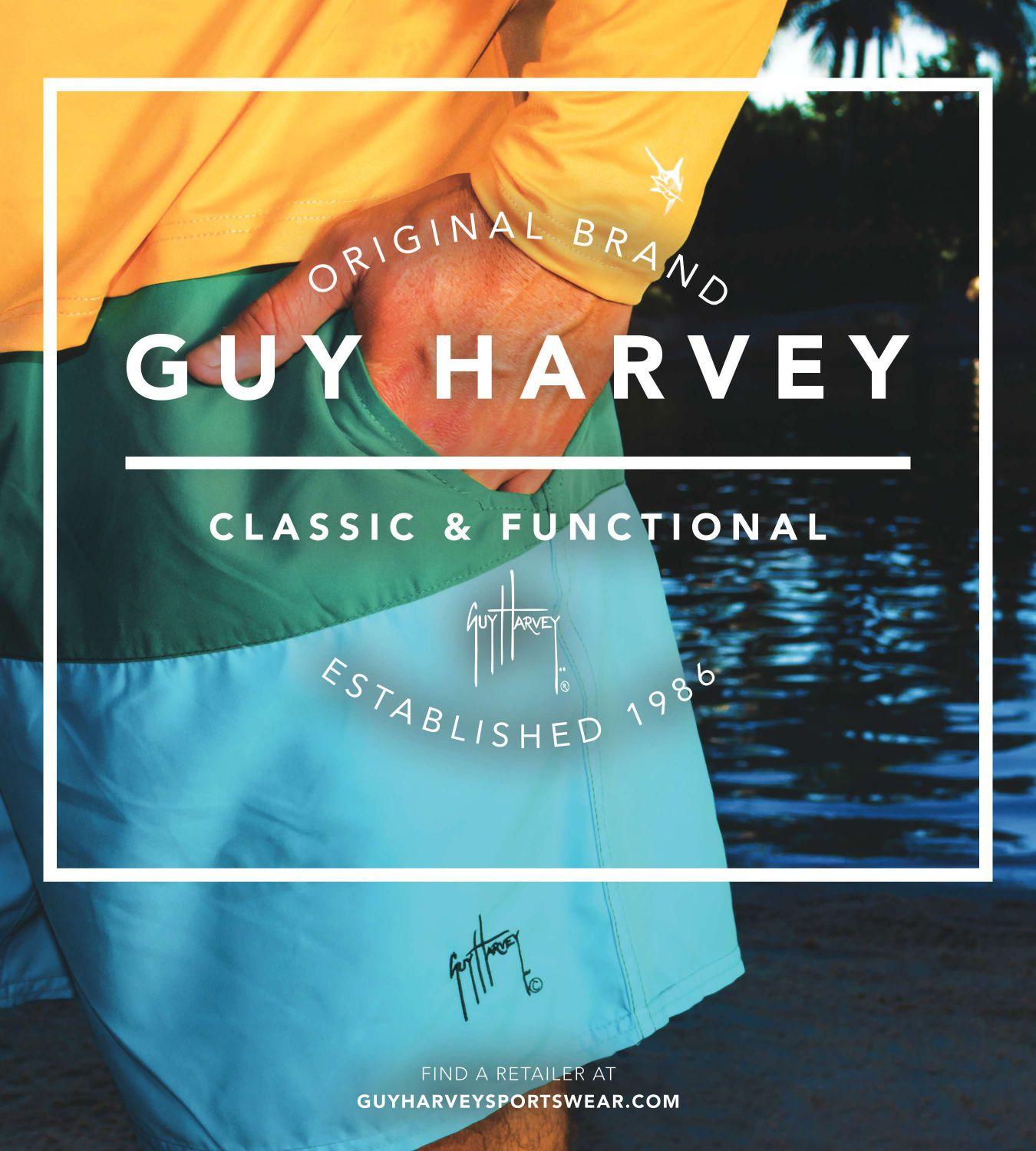
AFTCO





